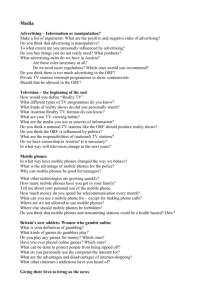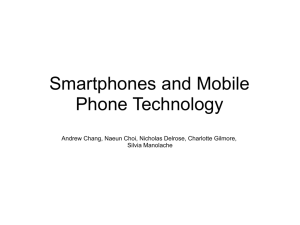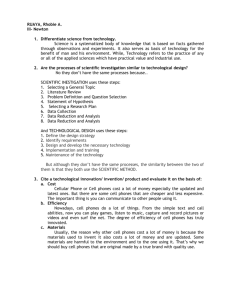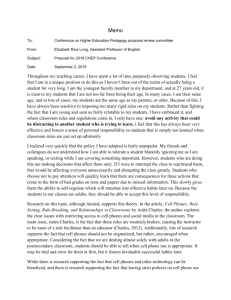Cell Phones and Human Health: An Update on Research and
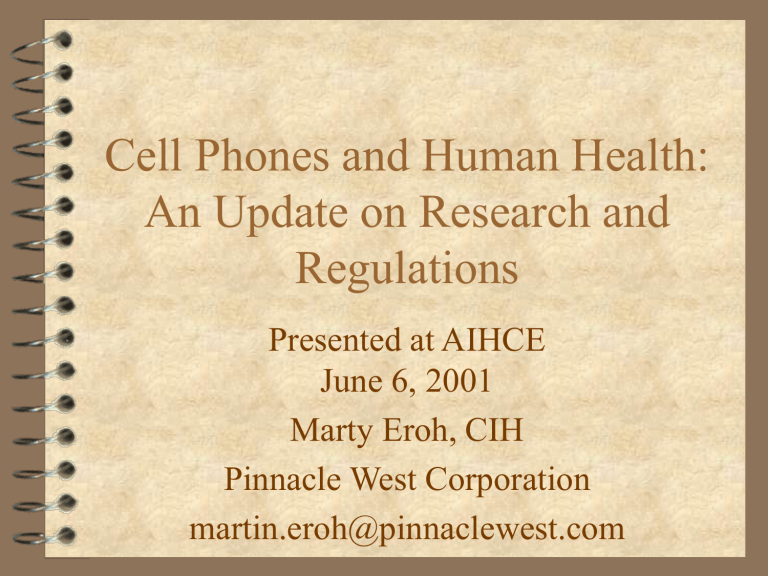
Cell Phones and Human Health:
An Update on Research and
Regulations
Presented at AIHCE
June 6, 2001
Marty Eroh, CIH
Pinnacle West Corporation martin.eroh@pinnaclewest.com
Cell Phone - Background
Use of cell phones has grown dramatically over the last fifteen years.
Operate at frequencies slightly higher than TV and
FM Radio signals (Nonionizing).
Analog and digital phones operate in the frequency range of 900 - 1800 MHz.
The maximum powers of these phones are 2W and
1W (900 and 1800 MHz respectively). Average power are 1/8 of maximum.
EM Spectrum
Basic Operation
Mobile phones communicate with base stations (fixed installations).
Base stations have limited range, therefore requires a nationwide network.
– Macrocells - up to about 22 miles, power output in tens of watts.
– Microcells - infill, airports, railway stations.
Range of few hundred yards.
–
Picocells - Sited inside buildings. Low power.
Sources of Exposure
Mobile phones and base stations exposures reduce with distance from the source.
Mobile phones - principal exposure is to the side of the head for hand held, or to other body parts during hands free use.
Base station exposure is whole body, but much lower intensity than from handsets.
Typical and Atypical Base
Stations
Typical and Atypical Base
Stations
Typical and Atypical Base
Stations
Typical and Atypical Base
Stations
Typical and Atypical Base
Stations
Typical and Atypical Base
Stations
Current Basis of Exposure
Guidelines
Primary sources of exposure guidelines, including IEEE, ICNIRP, NRPB are all based on avoiding thermal effects.
Some variation in the limits, e.g. some limits build in a safety factor for the general public vs workers.
Exposure Limits (cont.)
Most exposure limits are now provided in two forms:
–
Basic Restrictions - based on SAR - difficult to measure.
–
Reference or Investigation Levels - based on field strengths (v/m, A/m, or W/m2), more easily measured.
Can exceed the reference levels as long as the basic restrictions are not exceeded.
Example of ICNIRP Guidelines
Basic restrictions
Whole Body SAR =
0.4 (0.08) W/kg averaged over 6 minutes.
Head / trunk SAR =
10 (2) W/kg based on
10 grams of mass and
6 minute average.
( ) denotes public.
Reference level for general public at cell phone frequency
1800 - 1900 MHz = 9
- 9.5 W/m2 (based on f in MHz/200)
Are there Non-thermal Effects?
Is there justification for standards below thermal limits?
Do biological effects = adverse health effects?
What areas of research deserve attention?
What approach should be taken while research is being completed?
IEGMP
Independent Expert Group on Mobile
Phones report from Great Britain, April
2000.
Good overall summary of the science to date.
Review this report and a few more recent publications.
IEGMP Overall Conclusions
Despite widespread use, there is little research specifically relevant to cell phones.
The balance of evidence to date suggests that there are no adverse health effects below current ICNIRP guidelines (only thermal effects).
Some evidence for biological activity below the guidelines, but not clear that they lead to disease.
IEGMP Overall Conclusions
(Cont.)
Not possible to say that exposures below guidelines are totally without potential adverse health effects; knowledge gaps justify precautionary approach .
Due to well-documented detrimental effects drivers should be dissuaded from using either hand-held or hands-free phones while on the move.
Biological Interaction
Force produced by an electric field on charged objects (ions in the body) causes them to move, results in electric currents.
Currents flowing through resistance of the material results in heating. Heat input causes increased blood flow for heat dissipation (equilibrium).
Increase in brain temp by cell phones is estimated to be 0.1 C (to equilibrium).
Biological Interaction
The energy quanta at cell phone frequencies is 4 - 7 micro eV (millionth of eV). Energy needed to break chemical bonds in DNA is
1 eV. Insufficient power to break bonds.
Electric field created in biological tissue.
But to produce detectable changes, these fields would need to be greater than thermal or random noise.
Potential Biological Interaction
Could fields induce cell polarization?
Could fields affect movement of ions through cell membrane channels?
Does it increase ODC Activity?
Do fields effect gene expression?
Others?
If any of these effects are real, do they result in an adverse health outcome?
Epidemiologic Evidence
Few studies directly examining cell phones and health effects.
Latency of certain diseases, changes in technology, and changes in usage patterns, is an overall weakness in cell phone epidemiology.
Two Recent Hospital Based
Case-Control Studies
Muscat et al., JAMA 2000; 284:3001-7
Inskip et al., NEJM, 2001;344: 79-86
469 and 782 cases of brain CA respectively.
Controls were either benign disorders or cancers other than lymphoma and leukemia.
Exposure assessment through questionnaire.
–
Duration and frequency of use.
–
Type of phone, handedness
Results of Muscat and Inskip
No association between measures of cell phone use and risk of brain cancer (total, site specific, or by histological type).
Limitations
– Exposure assessment (questionnaire)
–
No measurements
– Low usage / short latency
–
Hospital controls
Cohort Study in Denmark
Johansen et al., Journal of the NCI, 2001
Nationwide cohort study of cell phone users.
Linked to Danish cancer registry.
Standardized Incidence Ratios (SIR) observed to expected.
Denmark Study - Results
No excess risk of any cancers. Example
SIRs.
All cancers: 0.86 (men), 1.03 (women)
Brain / nervous system: 0.95 (m), 1.03 (w)
Salivary gland: 0.78 (m), 0 cases in women
Leukemia: 0.97 (m), 1.07 (w)
Recommended Research
(IEGMP)
Epidemiologic studies. Case control and cohort. Particularly due to latency and changes in technology.
Studies of brain function.
Consequences of exposures to pulsed fields.
Subcellular and cellular research.
Improved exposure assessment
50:50 funding, independent panel
IEGMP Precautionary Approach
Prefer the two-tiered approach to exposure limits - general public versus workers, or controlled versus uncontrolled environments.
Establishment of exclusion zones around base stations where exposure guidelines may be exceeded.
Signs on micro and picocell transmitters stating do not open when in use.
IEGMP Precautionary (cont.)
More open process in the siting of base stations.
Pursue a policy of mast sharing and roaming where practical to minimize base stations.
Provide information on SAR to mobile phone consumers.
IEGMP Precautionary (cont.)
Non-essential use of cell phones by children should be discouraged.
Drivers should be dissuaded from using any type of cell phone while moving.
Cautious Inaction
Trichopoulos from Harvard and Adami from
Karolinska Institute, Editorial in NEJM:
Discussing radio-frequency energy stated:
– ‘…the lack of a theoretical foundation and the absence of empirical evidence of a substantial increase in risk legitimize cautious inaction, unless and until a small excess risk is firmly documented.’
SUMMARY :
Known Risks:
–
Heating - existing standards are protective.
– Use of cell phone while driving.
Need For Further Research - Potential nonthermal effects and long term epidemiology.
In the interim: Precautionary Approach or
Cautious Inaction.
Regulatory / Exposure Guidance
FCC
–
47 C.F.R., Part 1 Subpart I (1.1301 - 1.1319)
NEPA
–
47 C.F.R.,Part2 Subpart J (2-1091 - 2-1093) RF
Exposure, Mobile and Portable Devices
– OET Bulletin 65, “Evaluating Compliance with
FCC Guidelines for Human Exposure to RF
EMF,” 8/97 (http://www.fcc.gov/oet/rfsafety)
–
OET Bulletin 56, Q&A About the Biological
Effects & Potential Hazards of RF EMF.
Regulatory / Exposure Guidance
(cont.)
IEEE C95.1-1991 (1999 Edition), IEEE Standard for Safety Levels with Respect to Human
Exposure to Radio Frequency Electromagnetic
Fields, 3 kHz to 300 GHz
IEEE C95.2-1999, IEEE Standard for
Radiofrequency Energy and Current Flow
Symbols
IEEE C95.3-1991, IEEE Recommended Practice for the Measurement of Potentially Hazardous
Electromagnetic Fields - RF and Microwave
Selected Bibliography
Adey, WR et al. Spontaneous and nitrosourseainduced primary tumors of the central nervous system in Fischer 344 Rats exposed to frequency modulated microwave fields. Cancer Research,
60: 1857-1863, 2000.
Elwood JM. A Critical Review of Epidemiologic
Studies of Radiofrequency Exposure and Human
Cancers. Environ Health Perspectives, 1999:107
(suppl 1): 155-168
Selected Bibliography (Cont.)
Inskip, PD et al. Cellular telephone use and brain tumors. New England Journal of Medicine,
January 11, 2001.
Inskip, PD. Frequent radiation exposures and frequency-dependent effects: the eyes have it.”
Epidemiology, 12(1):1-4, 2001.
Johansen, C et al. Cellular telephones and cancer – a nationwide study in Denmark. Journal of the
National Cancer Institute, 93(3): 203-07, 2001.
Selected Bibliography (Cont.)
Lai, H; Singh, NP. Acute low-intensity microwave exposure increases DNA single-stranded breaks in rat brain cells. Bioelectromagnetics 16(3):207-
210, 1995.
Lai, H; Singh, NP. DNA single- and double-strand
DNA breaks in rat brain cells after acute exposure to low-level radiofrequency electromagnetic radiation. International Journal of Radiation
Biology, 69:513-521, 1996.
Selected Bibliography (Cont.)
Krewski, D et al. Potential health risks of radiofrequency fields from wireless telecommunications. Journal of Toxicology &
Enviornmental Health Part B: Critical reviews,
4(1): 1-143, 2001.
Krewski, D et al. Recent advances in research on radiofrequency fields and health. Journal of
Toxicology & Enviornmental Health Part B:
Critical reviews, 4(1): 145-159, 2001.
Selected Bibliography (Cont.)
Morgan, RW et al. Radiofrequency exposure and mortality from cancer of the brain and lymphatic/hematopoietic systems. Epidemiology, vol. 11(2): 118-27, 2000.
Moulder, JE et al. Cell phones and cancer: what is the evidence for a connection? Radiation
Research; 151(5): 513, 1999.
Muscat, JE et al. Handheld cellular telephone use and risk of brain cancer. JAMA, 284(23): 3001-7,
2000.
Selected Bibliography (Cont.)
Park, RL. Cellular telephones and cancer : how should science respond? Journal of the National
Cancer Institute, 93(3): 166-67, 2001.
Repacholi, M et al. Lymphoma incidence in Eu-
PIM-1 transgenic mice exposed to 50 Hz magnetic fields for up to 18 months: experimental methodology and exposure system. 17th Annual
Meeting of the Bioelectromagnetics Society, June
18-22, Boston, MA, 1995.
Selected Bibliography (Cont.)
Stang, A et al. The possible role of radiofrequency radiation in the development of uveal melanoma.
Epidemiology, 12:7-12, 2001.
Sienkiewicz, ZJ et al. Low level exposure to pulsed 900 MHz microwave radiation does not cause deficits in the performance of a spatial learning task in mice. Bioelectromagnetics, vol.
21: 151-158, 2000.
Selected Bibliography (Cont.)
Stewart, W. Mobile phones and health.
Independent Expert Group on Mobile Phones
(IEGMP) // Website: http://www.iegpm.org.uk/IEGMPtxt.htm//
Vijayalaxmi et al. Cytogenetic studies in human blood lymphocytes exposed in vitro to radiofrequency radiation at a cellular telephone frequency ( 835.62 Mhz, FDMA) Radiation research, 155: 113-121 2001
Selected Bibliography (Cont.)
Inquiry into Electromagnetic Radiation,
Parliament of the Commonwealth of Australia,
Report of the Senate Environment,
Communications, Information Technology and the
Arts References Committee, May 2001, http://www.aph.gov.au/senate/committee/ecita ctte/EMR/contents.htm

